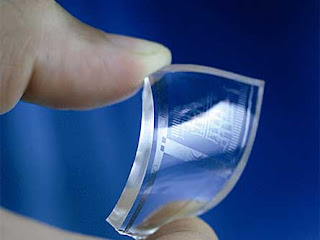"INSIDE every pencil, there is a neutron star waiting to get out. To release it, just draw a line. The soft, silvery-grey form of pure carbon found in pencils consists of stacked-up sheets of interlinked carbon atoms. Separate these sheets to obtain gossamer films of carbon just one atom thick and you have a material called graphene, whose properties mimic those of the exotic substances found in collapsed stars.Graphene even shares properties with materials that were around in the first instants of the big bang"
is how Philip Ball describes Graphene in New Scientist.
Graphene is basically a one atom thick planar sheets of sp2 bonded Carbon atoms which are densely packed in a honeycomb crystal lattice. The sp2 bonding gives Graphene its planar structure and hence its interesting properties. However, single layers of Graphene had not been studied till recent years. However Andre Geim from University of Manchester UK and his colleagues recently found out a strikingly simple method to extract single layer of Graphene from Graphite. And guess what?! The Nobel Prize Physics 2010 goes to Andre Geim!
So, what is so special about Graphene? What's this new method of extracting it and as always, what does these fin dings mean? Lets explore...
What makes Graphene special?
If you are familiar with the conduction of electricity in different materials then you ought to be knowing that electrons face obstructions while passing through a crystal or whatever. The impurities in a crystal makes the electron to scatter hence offering the resistance. But surprisingly, in Graphene this is not so. When the electrical conductivity of Graphene was tested by Geims group, it was found out that electrons could move very large distances in it without obstructions! No body knows how! Its conduction seemed to be promising to give a new generation of efficient devices.
When this itself was surprising, Graphene held new surprises. As you know electrons are quqntum objects. They can spread through in space and interact with each other as they are electrically charged. This collective movement can be viewed as the behavior of a single particle called Quasi particle by physicists. The interesting thing is the Quasi-particle in Graphene is nothing like the quasi-particles in other conducting materials. The quasi particles of Graphene behave in such a way that the electrons should be moving closer to the speed of light in the Graphene membrane. This equals neutron stars or the movement at the time of big bang. Creating such fast moving electrons takes particle accelerators of great investments!
Fine! What's more? Graphene allows us to study several peculiar phenomenons. One of them is Zitterbewegung meaning 'jittery motion' in German. When electrons move with immense speeds they do not tarvel in straight lines but follow a jittery motion claims the theory by Paul Dirac. This is due to the creation of positrons by the electrons itself and the interaction that follows. Nobody has observed Zitterbewegung since the oscillations are too rapid to detect. But Geim claims that this effect occurs in and can be studied through Graphene. Geim believes it might be possible to spot the jitter in Graphene using a high-resolution microscope that images the density of electrons in materials.
Now, coming to the mechanical properties of Graphene. As of last year, Graphene is the strongest material ever tested! Its breaking strength is 200 times that of the steal, a bulk strngth of 130GPa. Sounds like a wonderful material isn't it? Lets now see how embarrassingly simple was the method of extracting Graphene through flakes of sheets in Graphite.
Method of separation:
The chief problem in separating individual Graphene layers from Graphite was that the layers of carbon atoms tend to attract each other, which makes it hard to separate them from the stacked sheets of graphite. Yet Geim's team has found a way that now sounds embarrassingly simple. They etched out some islands in a flake of graphite, stuck some Scotch tape over them and pulled. This stripped off several layers of graphene at a time. By repeating this process, they gradually pared the islands down to just a few layers, or sometimes just a single layer, of graphene. That's all!
What are the promises?
As mentioned earlier, Graphene can be used to study several interesting phenomenons. Not only that, Graphene has several other applications too. Graphene makes an excellent sensor due to its 2D structure. The fact that its entire volume is exposed to its surrounding makes it very efficient to detect adsorbed molecules. Molecule detection is indirect: as a gas molecule adsorbs to the surface of graphene, the location of absorption experiences a local change in electrical resistance. While this effect occurs in other materials, graphene is superior due to its high electrical conductivity (even when few carriers are present) and low noise which makes this change in resistance detectable.
Researchers are running into the physical limits of speed and scaling in silicon transistor technology, forcing them to look elsewhere for next-generation devices. The leading candidate to replace silicon being pursued by, well, pretty much everyone, is graphene.
Graphene nanoribbons often abbreviated GNRs, are thin strips of graphene or unrolled single walled carbon nano tubes. Their 2D structure, high electrical and thermal conductivity, and low noise also make GNRs a possible alternative to copper for integrated circuit interconnects.
Graphene's modifiable chemistry, large surface area, atomic thickness and molecularly-gatable structure make antibody-functionalized graphene sheets excellent candidates for mammalian and microbial detection and diagnosis devices.
Thus Graphene has wide variety of applications and stands as a material with splendor!
See also:
*See Philip Ball's article on New Scientist "Quantum weirdness on the tip of your pencil"
*See wikipedia on Graphene
*See Nature's article on Graphene nanoribbons for technical details
*See an interesting article on graphene transistors in arstechnica

No comments:
Post a Comment